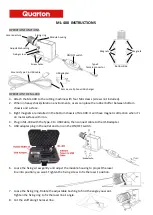
stewmac.com
9
Spray schedule with ColorTone Aerosol Lacquer
This finishing process can be completed in as little as three
days, followed by a week of curing. Remember that patience
is the key to a successful finish job. Don’t rush it! Spray the
lacquer using light passes to prevent runs.
Day 1
Body: Spray 1-3 coats of aerosol Sanding Sealer on the body,
waiting 1-2 hours between coats.
Neck: Spray 1-2 coats of Clear Satin lacquer, allowing 1 hour
between coats. Follow this with 1-2 coats of our Aged Clear
lacquer for a warm maple color. Wait 1 hour between coats.
Note: If your fretboard is maple, you will be spraying over
the entire neck, including the frets. Finish will be removed
from the frets during the leveling and dressing process after
it has cured. The nut will be taped off to keep it unfinished.
Any excess overspray can be scraped away after finishing.
Allow the body and neck to dry overnight.
Day 2
Body: Spray 2-3 coats of color (optional), allowing 1 hour
between coats.
Body and neck: Spray 3-4 additional coats of Clear Satin, 1
hour apart.
Allow to dry overnight.
Day 3
Body and neck: Lightly sand the body and neck with 400-grit
paper to remove any finish spatter or dust.
Spray 3-4 additional coats of Clear Satin, 1-2 hours apart.
Allow the finish to cure for a week in a cool, dry room. Around
70° at 50% humidity is recommended.
After the finish has dried for 1 week, go over the entire
instrument lightly with Light Duty 3M Scotch-Brite Pads or
0000 steel wool for a nice satin appearance.
There are many finishes and application methods to choose
from. In creating these instructions, we’re using ColorTone
Aerosol Guitar Lacquers. These aerosols are a fast way to
build a quality finish.
Using a clear satin topcoat is recommended, because satin
doesn’t require much sanding or buffing the way gloss does.
If you choose to spray a glossy finish, it will involve more steps.
For help with that or any kind of finish, see our book,
Guitar
Finishing Step-By-Step
(#5095).
Use scrap wood to make a spray handle. Mark and drill holes
in the handle that align with the holes in neck pocket of
the body. Use two bolts and nuts to temporarily attach the
handle to the body. Drill a hole in the other end of handle
and bend a thin metal rod into an S-shape to hang the body
and neck during spraying or while drying.
A brushed-on finish like tung oil, waterbase lacquer, or
shellac works great too. Any of these finishes will seal and
protect the wood from dirt and moisture.
The best advice for finishing: practice on scrap!
Test your finish of choice on scrap wood first, so you can see
what you’ll get before applying it to your guitar.
Use warm lacquer, not cold. Professional finishers spray
heated lacquer because cold lacquer spatters, requiring extra
sanding. Warm up your aerosols before spraying by placing
the cans in a sink of warm tap water.
When spraying, keep the spray parallel to the surface of the
guitar for even coverage as shown below.
Spray the finish
The right way to spray: Move in a straight line, so the distance
from the work stays the same. This gives you even coverage.
Keep your
wrist flexible
Stiff wrist
The wrong way: Swinging in an arc moves the spray closer and
farther from the work. Center coverage is heavy, edges are light.






































